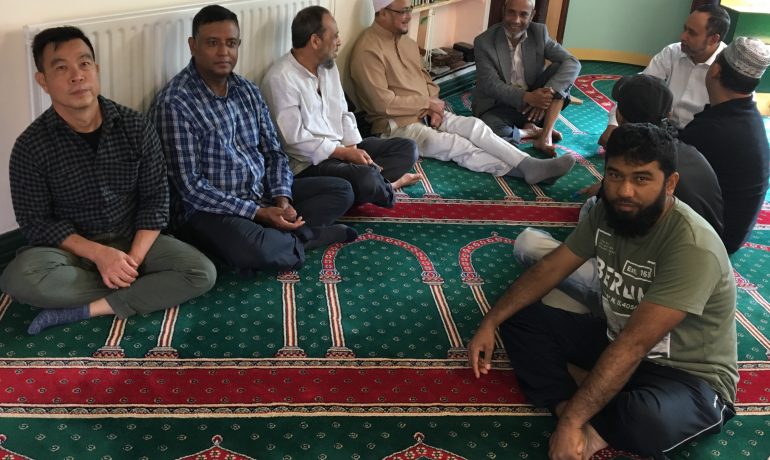Do community-engaged arts do any good to the community? Wong Hoy Cheong set out on a quest to find out, discovering that he sharpens and shares his critical consciousness through practice.
By Lee Kwai Han
On the evening of June 5, 2022, the PPR Jalan Sungai, a low-cost flat sitting next to Sungai Pinang, George Town, was filled with music and laughter. Parents and children gathered to enjoy an evening of dance, shadow puppetry, and photo exhibition after a five-month-long community-engaged art programme, Gempak 100. Wong Hoy Cheong was one of the mentors for the artists and cultural workers behind the programme.
Ten years ago, Wong designed a community engagement framework for a participatory budgeting project right here in PPR Jalan Sungai. Revisiting his community engagement practice over the years, he proposes a fundamental equivalence between art education in the community and the participatory budgeting project: one of giving a voice back to the community.
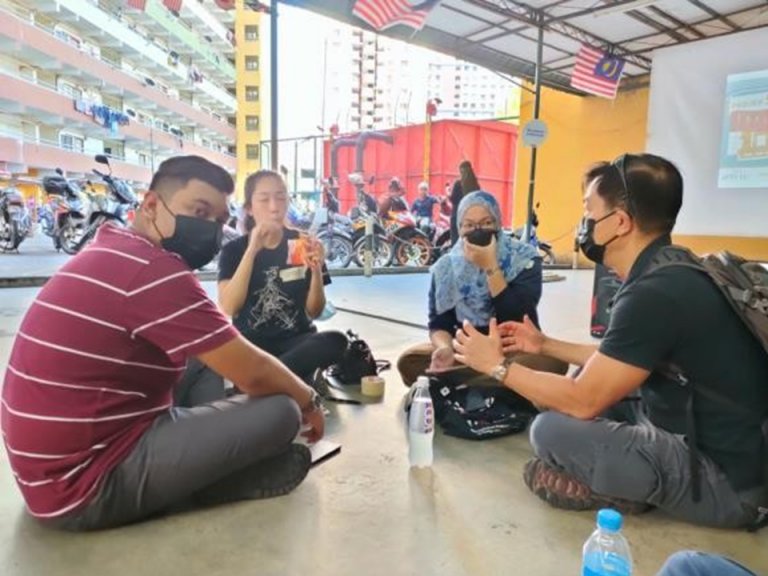
Wong Hoy Cheong (right, in black polo T-shirt) in a meeting with his mentees in PPR Jalan Sungai.
Photo courtesy of Persatuan Pendidikan Seni Pulau Pinang (Arts-ED).
Doubting the meaningfulness of the arts
Wong has always been interested in social issues. As an artist, educator, and social activist, he explores how and to what end art can be used in a social issue.
In 2007, Wong was invited to work with a Roma community in a historical, run-down neighbourhood in Sulukule, Istanbul. The community was being evicted to give way to an urban regeneration project. This three-month experience would raise a series of questions he keeps asking himself till today.
In Sulukule, he and his two facilitators engaged the Roma children to examine the eviction issue through art. However, he soon found a stark contrast between his artistic ideals and reality. “They still want to live as children, with dreams, with fun, playing football while their parents’ houses are being torn down.” He realised the children were not socially-conscious about the issue while making art about it.
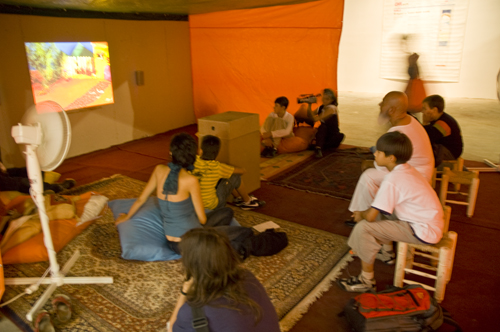
The Roma children and their Imam had a preview of the video they made with Wong, Oh Sulukule, Darling Sulukule (2007), in a tent with cushions during the Istanbul Biennial 2007.
Photo courtesy of Wong Hoy Cheong.
The project became famous in the art world. Yet, he started to question how meaningful arts education is in a community. “I got the fame…And then what happens to these children? They lost their homes. They still remain poor. What did they benefit from this whole process?”
He finds these questions unsettling. He needs to find the answer.
Before the ideals and the realities meets
He came to another urban regeneration project in 2010—for Taman Maju Jaya, a low-cost flat in Petaling Jaya. He engaged the different factions of the community via workshops and focus group discussions, this time, with careful thought about enhancing and bringing back activities to the common space.
However, as he explored the problems with the community, he realised the problem was much larger and more complicated. Their septic tank, situated right under their courtyard, was leaking. The technical and funding requirement to solve this issue was far beyond the project’s capacity.
Again, Wong was hit by the gap between ideals and reality. He deemed this project a big failure for failing to address the urgent and practical concerns of the community.
When voices are being listened to
Then in 2012, he finally found one of his most rewarding projects back in his hometown. Wong designed a four-phase community engagement framework for a gender-responsive and participatory budgeting project in PPR Jalan Sungai.
Through an eight-month engagement, the flat community decided to claim back the building maintenance and cleaning work, which the town council had been outsourcing. The flat residents formed a cleaning team and they were contracted to serve their community. Wong is glad to see the building is much cleaner and better-maintained until today.
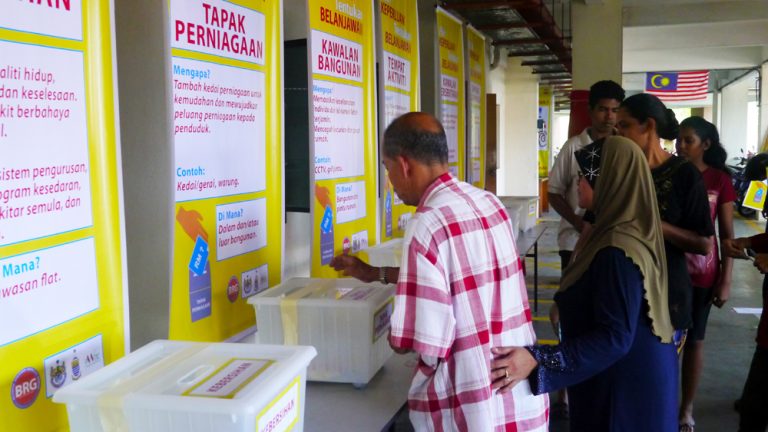
Community members of PPR Jalan Sungai voted for areas that should be prioritised in the council’s budgeting for their flat.
Photo courtesy of Wong Hoy Cheong.
“It’s about giving back the voice to the community. They will continue to feel they have a voice to speak up, even after we leave. That’s the most important thing. Art education should also perhaps take that up,” Wong says. This way, artists’ work with the community would last beyond the project.
Finding the key to sustainability
Since his Sulukule project, Wong has not stopped contemplating how short-lived many community-engaged art projects are. He has been trying to change the situation.
He shares about working with a Muslim migrant community in Folkestone, England for seven years now. It started with making art together with the Folkstone Mosque community in 2015. The project has slowly grown into a new phase, where the congregation invited Wong to help engage the different factions of the community on their mosque expansion plan.
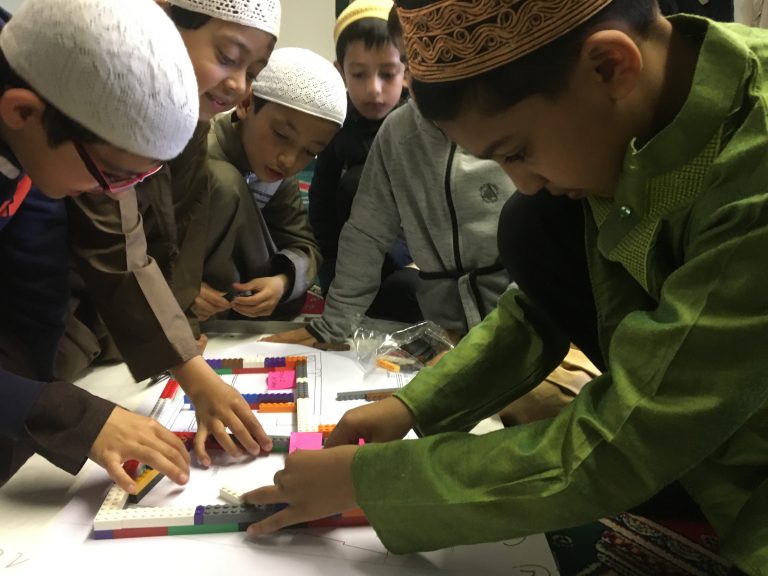
Wong thinks play is an effective way to explore the concerns and needs of children, a group that is often marginalised in a decision-making process.
Photo courtesy of Wong Hoy Cheong.
He enjoys how his relationship with the community has evolved into friendship and he now shares the ups and downs of the community. He learned being with the community is crucial to building trust and working with long-lasting effects.
On the other hand, the growth of the project also enables the further exchange of thoughts and skills with his less experienced collaborators. He notes its difference from the formal mentor-mentee relationship in Gempak 100. To him, learning through a collaborative relationship is what he feels more comfortable with.
Acting and reflecting
As he has been practicing himself, learning is an ongoing process of acting and reflecting.
Wong is increasingly conscious of his community engagement practice, as he continues to practice and reflect on his experience. He emphasizes it is important for one to be conscious of the purpose and impact of one’s actions when working with communities.
All in all, when you “go into a community, the most important, your motto should be: let us not do harm, rather let us do good. Because when moving into a community, if you’re not prepared, you can do harm,” Wong says.
Cover Image: Wong Hoy Cheong (left, in a black checked shirt) and the Folkestone community after a Friday prayer. Courtesy of Wong Hoy Cheong.
Lee Kwai Han manages arts and environmental education projects in Penang. Despite her training in engineering, she believes arts is the software solution our society needs.

